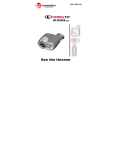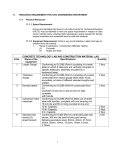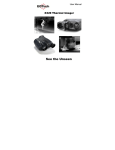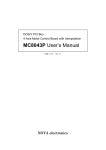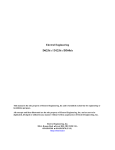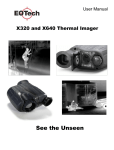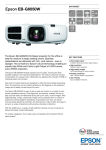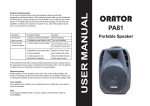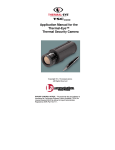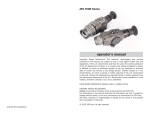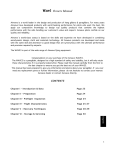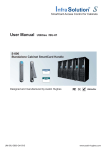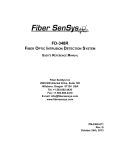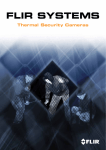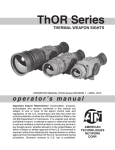Download Palm IR 250 User Manual
Transcript
Instruction Manual Manual P/N 3261607 Rev D WARNING – This document may contain technology within the definition of the Export Administration Regulations (EAR) and is subject to the export control laws of the U. S. Government. Transfer of this technology by any means to a foreign person, whether in the U. S. or abroad, without an export license authorization from the U. S. Department of Commerce, is strictly prohibited. 2 Welcome to the World of Thermal-Eye™ Infrared © COPYRIGHT 2004 ALL RIGHTS RESERVED Worldwide Patent Rights Reserved. This product is covered by one or more of these US Patents: 4,379,232; 5,047,644; 5,144,133; 5,264,326; 5,478,242; 5,577,309; 5,629,074. Other patents pending. 3 Product Usage Notations ____________________________ 4 Important Safeguards ______________________________ 6 Camera and Technology Overview ___________________ 10 Battery Care and Use Instructions ___________________ 12 Operating Your Camera____________________________ 18 Power / Standby Switch _________________________ 18 Viewfinder Display Orientation___________________ 19 Control Buttons________________________________ 20 Menu Navigation _____________________________ 21 AUTO Mode _________________________________ 22 Manual Mode ________________________________ 22 Camera Connectors ____________________________ 26 Video output / RCA jack________________________ 26 RS-232 Connector_____________________________ 26 Symptom and Solution Troubleshooting_______________ 27 Additional Information ____________________________ 29 Performance Parameters ________________________ 29 Interfaces _____________________________________ 29 Electrical _____________________________________ 29 Physical ______________________________________ 30 Environmental_________________________________ 30 Environmental Testing _________________________ 30 Use and Care of Optional Lenses ____________________ 31 Description____________________________________ 31 Operation_____________________________________ 32 Installation / Removal___________________________ 32 Cleaning ______________________________________ 33 Removal/Installation of 75EF Lens Assembly _______ 34 Installation of Optional Lens Assembly ____________ 34 Installation of Optional Lens Assembly ____________ 35 Warranty Information _____________________________ 39 4 Product Usage Notations WARNING: TO REDUCE RISK OF FIRE, ELECTRIC SHOCK, OR DAMAGE TO CAMERA: 1)DO NOT OPEN CAMERA, NO USERSERVICEABLE PARTS. 2)DO NOT EXPOSE TO CONTINUOUS RAIN OR MOISTURE. 3)USE RECOMMENDED ACCESSORIES ONLY. This equipment has been tested and found to comply with the limits for a Class A digital device, pursuant to Part 15 of the FCC rules. These limits are designed to provide reasonable protection against harmful interference when the equipment is operated in a commercial environment. This equipment generates, uses, and can radiate radio frequency energy and, if not installed and used in accordance with the instruction manual, may cause harmful interference to radio communications. Operation of this equipment in a residential area is likely to cause harmful interference in which case the user will be required to correct the interference at own expense. If this equipment does cause harmful interference to radio or television reception, which can be determined by turning the equipment off and on, the user is encouraged to try to correct the interference by one or more of the following measures: — — — — Reorient or relocate receiving antenna. Increase separation between equipment and receiver. Connect the equipment into an outlet on a circuit different from that to which the receiver is connected. Consult a dealer or an experienced radio/TV technician for help. CAUTION: DO NOT REMOVE THE COVER. THERE ARE NO USER SERVICEABLE PARTS INSIDE. REFER SERVICING TO QUALIFIED SERVICE PERSONNEL 5 Product Usage Notations (cont’d) CE Manufacturers Declaration of Conformity (European Compliance for Electromagnetic Immunity) Product Identification Product Thermal Infrared Camera Brand Thermal_Eye™ Model/Type Version Manufacturer Name Address Country Telephone Thermal-Eye™ 250D Digital 3261605 L-3 Communications Infrared Products 13532 North Central Expressway PO Box 741148, MS 37 Dallas Texas 75374-1148 USA 800-990-3275 EU Representative Company Address Country Phone BFi OPTiLAS INTERNATIONAL SA Z. I. La Petite Montagne Sud 4 allée du Cantal – 91018 EVRY CEDEX France 33 - (0) 1 60 79 59 55 A sample of the product has been tested as follows: Meets Standards EN50081-1, EN50081-2 EN50082-1, EN61000-6-2 Tested by Nemko Dallas, Inc 802 North Kealy Road Lewisville, Texas 75057–3135 Means of conformity The product is in conformance with the above standards according to 89/336/EEC. 6 Important Safeguards The exclamation point within an equilateral triangle is intended to alert the user to the presence of important operating and maintenance (servicing) instructions in the literature accompanying the product. 1) Read and retain these safety and operating instructions for future reference. 2) Cleaning - Do not use liquid cleaners, glass cleaners, or aerosol cleaners. Use a damp cloth for cleaning the housing. Use the lens cloth provided to clean the front lens. 3) Attachments – Use only attachments recommended by the manufacturer. 4) Water and Moisture - The Thermal-Eye™ 250D Camera housing is designed to protect the camera from occasional splashing water. Do not operate in continuous rain conditions. 5) Accessories - Do not place this product on an unstable cart, stand, tripod, bracket, or table. The product may fall, causing serious injury to a child or adult, and serious damage to the product. 6) Power Sources - This product should be operated only from the type of power source indicated on the marking label. For products intended to operate from battery power, or other sources, refer to the operating instructions. 7) Servicing - Do not attempt to service this product yourself. Refer all servicing to qualified service personnel. Opening the product (except for changing of interchangeable lenses) will void your warranty. 8) Damage Requiring Service - Refer servicing to qualified service personnel under the following conditions: 7 Important Safeguards (cont’d) a) if liquid has been spilled, or objects have fallen into the product b) if the product has been exposed to rain or water and is no longer working c) if the product does not operate normally by following the operating instructions d) if the product has been dropped or damaged in any way e) when the product exhibits a distinct change in performance - this indicates a need for service. 9) Replacement Parts – Use only manufacturer approved replacement parts and accessories. 10) Heat - The product should be situated away from heat sources such as radiators, heat registers, stoves, or other products (including amplifiers) that produce heat. Restrictions of Use The following disclaimers apply as non–standard, non–warrantied applications: — — — — — — Unit’s viewfinder has limited angular travel for viewing. Do not force viewfinder beyond these limits. Unit is not intended for permanent, fixed– mount outdoor applications. Unit is not designed to withstand immersion or continuous exposure to rain. Unit is not intended for continuous exposure to a salt water atmosphere. Unit is not intended for dynamic–mount applications, such as on vehicles or heavy machinery, in which transmitted vibration is continuously sustained. Unit should be placed in carrying case when not in use. 8 Unpacking Your Equipment We are pleased that you have selected the ThermalEye™ 250D Camera. We suggest that you read this manual carefully and retain it for future reference. Check the contents of the case for the following: Thermal-Eye™ 250D Digital Camera Battery Charger (Model Shown 3261605) *Lens option indicated by dash Lens Cover, (NOT SHOWN), 3193920-1 Durable Carrying Case, (NOT SHOWN), Part No. 3193777-5 for 25/50/75mm lens, Part No. CD10150 for 100/150mm lens Lens Cleaning Cloth, (NOT SHOWN), PN 3193777-11 Battery Charger Kit (NOT SHOWN) PN 99-UNVCHRG for Kit (110/220V) Rechargeable Battery (NOT SHOWN), PN 3193777-1 Soft Cover for Additional Field Protection (NOT SHOWN), Fits cameras with all lenses except 100mm and 150mm (sold separately) 9 L-3 CIP Effective Part Focal Number* Length NTSC Configuration Comment 3261605-1 75mm Standard, Motorized Focus, no Iris 3261605-2 50mm Manual Focus, with Iris 3261605-3 25mm Manual Focus, with Iris 3261605-4 100mm Motorized Focus, no Iris 3261605-5 150mm Motorized Focus, no Iris 3261605-7 75mm PAL Configuration Manual Focus, no Iris 3261605-11 75mm Standard, Motorized Focus, no Iris 3261605-12 50mm Manual Focus, with Iris 3261605-13 25mm Manual Focus, with Iris 3261605-14 100mm Motorized Focus, no Iris 3261605-15 150mm Motorized Focus, no Iris 3261605-17 75mm Manual Focus, no Iris *Lens option indicated by dash number (See Use and Care of Optional Lens Assemblies) 10 Camera and Technology Overview Background The Thermal-Eye™ 250D Camera is a part of the L-3 Communications Infrared Products (L-3 CIP) Thermal-Eye™ product line. Thermal-Eye™ 250D is a revolutionary thermal imaging system that is the result of many years of research and experience. L-3 CIP has long been a leader in the production and development of night vision systems based on infrared thermal imaging. Over the years, L-3 CIP’s experience has lead to many improvements in performance and reliability of night vision systems. In an effort to make this technology more affordable, L-3 CIP’s engineers and scientists developed a unique way of translating infrared energy into electronic signals. This innovation, combined with experience in developing and building military night vision systems, has lead to the creation of Thermal-Eye™ 250D Camera. Now L-3CIP is providing affordable commercial thermal imaging solutions for law enforcement, marine, security, and other commercial uses while continuing to supply other special products that meet the particular needs of the military. Customer Service At L-3 Communications Infrared Products (L-3 CIP), we have made considerable investment in training our personnel, and we are equipping and training our dealers to help you install and apply our Thermal-Eye™ products. If you have questions or comments, please call Customer Service at 800-990-3275. Infrared Imaging and Applications Visible light, the rainbow of colors that can be sensed by the human eye, is electromagnetic radiation within a certain frequency band. ‘Infra-‘ means ‘below’ and ‘red’ is the lowest frequency in the visible spectrum. Hence, ‘infrared’ (or ‘IR’) refers to that range of electromagnetic wavelengths just below that capable of sight by the human eye. In the IR range, energy from a scene is not sensed by sight (light) but rather by temperature. 11 Camera and Technology Overview (cont’d) Most objects that you see are not radiating visible light but instead, are reflecting light radiated from another source. Most objects have to be heated to extreme temperatures before they radiate energy in the visible light spectrum. However, energy in the infrared range is being radiated by all objects that are above absolute zero (-459F). Hence, everything has a thermal signature, regardless of light conditions. As the frequency of electromagnetic energy increases, the length of the waves decreases. Infrared shares many of the properties of visible light, but its different wavelength has several other unique characteristics. For instance, materials that are opaque to visible light may be transparent to infrared, and vice–versa. Infrared is less subject to scattering and absorption by smoke, smog, or dust than visible light, and infrared cannot be seen by the human eye. Different objects give off varying amounts of infrared, depending on the temperature of the object and also on a characteristic called emissivity.. Heavy rain, fog, and other environmental conditions may degrade infrared imagery, but an infrared thermal imager will still penetrate these obscurants better than the human eye, or other night vision technologies. The Thermal-Eye 250D infrared detecting system distinguishes between very small differences in thermal (infrared) radiation, converts it to electrical signals, amplifies those differences, and reproduces them correspondingly in the visible light (video) range. Powerful advantages are achieved in being able to turn a pitch black night into a black and white TV image of the scene. As your infrared knowledge and experience grows, further applications will develop as you recognize heat clues beyond the naked eye in both day and night conditions. 12 Battery Care and Use Instructions READ INSTRUCTIONS CAREFULLY BEFORE USING BATTERY. Instructions for Best Performance • The nickel metal hydride battery needs to be charged before use. Refer to “Battery Conditioning”. • When this battery is charged for the first time, the charger may indicate that charging has been completed after just 10 to 15 minutes. This is normal and can happen with any rechargeable battery when it is first charged, or, if it has been stored unused for a prolonged period. Simply remove the battery from the charger and repeat the charging procedure. There is no need to discharge the battery between these charges. • Best charging results are obtained at normal room temperature, 70 ± 8 °F (21 ± 2 °C). Charging beyond this range is permissible but will not result in the battery’s full capacity being reached. Charging at temperatures below 50 °F (10 °C) or above 95 °F (35 °C) is not recommended. • It is normal for the battery to become warm during charging or after use. • Nickel Metal Hydride batteries do not develop a ‘memory effect’ typical of other rechargeable battery types. Therefore, it is not necessary to fully discharge the nickel metal hydride battery before recharging, nor is it necessary to periodically “recondition” the battery. You can top–off the charge at any time. Note that performing a refresh or discharging a nickel metal hydride battery, though not required, will not harm the battery. 13 Battery Care and Use Instructions (cont’d) • All rechargeable batteries will gradually lose their charge over time when they are left in storage. If this battery will be left in storage for more than a few days prior to use, a top–off charge to regain full capacity is recommended. • Remove the battery from equipment, charger, or AC adapter when not in use. Store in a cool dry place. • Wipe the metal terminals with a soft, dry cloth if they become dirty. Safety Precautions • Do not disassemble or attempt to open the battery under any circumstances. • The battery can explode, leak, or catch on fire if heated or exposed to fire or high temperatures. • Do not short circuit the battery by directly connecting the metal terminals (+, -). Be certain that no metal objects such as coins, paper clips, etc. touch the terminals. • Only use the charger recommended by the device manufacturer. Instructions to Avoid Battery Damage • Do not drop this battery or subject it to mechanical shock. • Use the battery only with equipment that specifies its use. 14 Battery Care and Use Instructions (cont’d) Battery Conditioning Battery Charger Battery The battery provided comes fully discharged and requires some conditioning prior to use. We recommend conditioning your new battery as follows: 1. Plug battery charger into AC outlet or car battery adapter. • Power LED will light, indicating the charger/refresher is powered by either the AC adapter or the DC car plug. 2. Insert battery in battery charger adapter. • Place battery on battery charger with about 1/8 inch hanging over edge. • Press battery down against spring– loaded pins and slide battery in to place. 3. Press refresh button to discharge and then charge the battery. • Charge LED will light (amber), indicating that the unit is discharging a battery. 4. When battery begins fast-charging, charge indicator will light (red). 5. When battery is fully charged, the charge indicator will light (green). 15 Battery Care and Use Instructions (cont’d) CAUTION Leaving charged battery on charger for extended period of time will reduce battery life and performance. 6. Remove the battery from the battery charger. 7. Repeat steps 2. thru 6. three times prior to using battery. Charging Battery After Normal Use Use the ac/dc battery charger to charge the battery after exhaustion as follows: 1. Plug battery charger into AC outlet or car battery adapter. • Power LED will light indicating charger /refresher is powered by either the AC adapter or the DC car plug. 2. Insert battery in battery charger adapter. • 3. 4. Place battery on battery charger with about 1/8 inch hanging over edge. • Press battery down against spring–loaded pins and slide battery in to place. • Charge LED lights (red) indicating that the unit is fast–charging a battery. When battery is fully charged, the charge indicator lights (green). Remove the battery from the battery charger. 16 Battery Care and Use Instructions (cont’d) Installing Battery In Camera 1. Raise viewfinder up to access battery location at rear of camera. 2. While matching up contacts on battery and camera as shown below, insert the battery with approximately 1/8” overhang toward the viewfinder side. Next, slide the battery toward the hand grip which will lock it into place. Note: Although the battery will fit upside down without harm, the contacts will not make connection and the camera will not function. VIEWFINDER EJECT BUTTON -- BATTERY CONTACT + BATTERY CONTACT + CAMERA CONTACT + - - CAMERA CONTACT 3. To remove the battery after use, press the eject button and slide the battery toward the viewfinder side. 17 Battery Care and Use Instructions (cont’d) Battery Charger Warnings Do not try to open the battery charger. Warranty will be void if the unit is repaired by unqualified service personnel. Do not short the output terminals or contacts of the battery charger or a fire may result. Do not wet the charger or immerse it in water. Do not use or store it in a dusty area. This will cause premature wear of mating parts. If water or dirt should get on it, wipe it clean with a cloth dampened with a mild detergent, except all metal contacts. If necessary, clean the metal contacts with alcohol. Make sure that the input has been disconnected. Short Circuit Protection Systems The charger has built in protection against accidental shorting of the output contacts. Output power is automatically limited to avoid harm to the user. Fuse Replacement The input of the unit is protected by a 5 amp fuse located inside the lighter plug. Replace only with a 5 amp rated fuse as shown in the following illustration. CAP BURN T FUSE 18 Operating Your Camera Power / Standby Switch The Power / Standby Switch is a rotary switch below the viewfinder. The 0 position is OFF and the 1 position is ON. The intermediate position is STANDBY. STANDBY removes power from the video display, saving a small amount of power, but keeps the detector and electronics ready for instantaneous activation when the switch is rotated to the ON position. All camera functions are operational except the viewfinder in STANDBY. IR Camera video can also be sent to an external monitor or recorder in either ON or STANDBY positions by accessing the RCA jack under the rubber cover to left of switch. External video RCA jack is under right side of cover while the left side reveals a factory-use only connector. 19 Operating Your Camera (cont’d) Viewfinder Display Orientation The Viewfinder Display has a limited rotational travel. The display can travel from the Horizontal orientation to an elevated angle of approximately 80 degrees. Forcing the display to go beyond this limit will break the over travel stops and will damage the display. ~80 degs 20 Operating Your Camera (cont’d) Control Buttons Three control buttons provide mode and menu control. These are identified as MODE, ADJUST ( + & - ), and SELECT. Depressing either the MODE or SELECT button will display the camera menu at the bottom of the display. MODE - When the MODE button is pressed the camera will changes between the AUTO and Manual modes. ADJUST (+ / -) – When the ADJUST button is pressed, the item that is currently selected by the cursor will be changed. SELECT - When the SELECT button is pressed, the menu steps between the various menu items: POLARITY (WH = White Hot, BH = Black Hot); FOCUS; BRIGHTNESS; GAIN; and LEVEL. 21 Operating Your Camera (cont’d) A line above a menu item indicates control for that item is active. Note: the menu self-blanks after a few seconds of nonuse and may be recalled by pressing the SELECT button. Menu Navigation The menu has two levels, Main and Advanced. The Advanced Menu functions are described on Page 25. To toggle to the Advanced menu, position the cursor over the ADV symbol and press either ADJUST button. To return to the Main menu, position the cursor over RTN and press either ADJUST button. The Main menu contains functions for polarity mode (WH or BH), electronic zoom (ZM1X or ZM2X), electronic focus (FOCUS), display brightness (BRIGHT), automatic/manual mode (AUTO or Gxxx & Lxxx), and Advanced menu (ADV). Note that the battery symbol is only visible when the battery is low and needs to be changed. CURSOR WH ZM1X FOCUS BRIGHT AUTO Main Menu (Auto Mode) ADV 22 Operating Your Camera (cont’d) AUTO Mode The AUTO mode provides the easiest means of operating the Thermal-Eye™ 250D Camera. Video gain is automatically adjusted to the scene being viewed (after several seconds), and a properly adjusted image is shown in most situations. When viewing warm objects, such as people, automobiles, or boats up close, the video gain will automatically be decreased to provide more detail on facial features and flat surfaces. When viewing a scene with low thermal content, i.e. a park, field, or shaded roadway, the video gain is automatically increased to provide more detail in the scene. Manual Mode The Manual mode may be selected at any time to recall a favorite gain (Gxxx) and level (Lxxx) setting for a given set of viewing conditions. This favorite setting will be retained until the camera is turned off, no matter how many times you toggle between the AUTO and Manual modes of operation. Additionally, this setting may be set as the default camera setting by using SAVE function. CURSOR WH ZM1X FOCUS GXXX LXXX Main Menu (Manual Mode) ADV 23 Operating Your Camera (cont’d) GAIN Adjust A higher gain setting raises the sensitivity of the camera and provides more contrast on background features. A lower gain setting lowers the sensitivity and provides additional detail in hotter objects. LEVEL Adjust The level setting may be used to change the apparent video level of the image seen in the viewfinder (and through the RCA video jack). A lower level setting while in white hot (WH) mode also allows a higher gain setting to be used without saturating hot objects on the display. Polarity Control The polarity control is used to control whether warmer items in a scene appear as white (WH) or black (BH). Electronic Zoom The electronic zoom is used to “zoom in” on an image using the camera’s electronics to magnify the central region of the image. The zoom ratio is 2:1 when ZM2X is displayed and 1:1 when ZM1X is displayed. FOCUS Adjust For models with motorized focus lenses, the ADJUST buttons are used to focus the lens. The ADJUST buttons are active for FOCUS when the menu is blanked and when the menu is visible with the cursor on FOCUS. As a reminder, if the menu is visible and the cursor is over another function, the ADJUST buttons control that function, rather than FOCUS. Brightness Control The brightness control is used to set the internal viewfinder’s intensity. Set this to any level comfortable for viewing. 24 Operating Your Camera (cont’d) The Advanced menu contains functions for noise reduction (NR xxx), sharpness (SHARP xxx), power-up configuration saving (SAVE), and return to Main menu (RTN). As in the Main menu, the battery symbol is only visible when the battery is low and needs to be charged. CURSOR NR OFF SHARP OFF SAVE RTN Advanced Menu Noise Reduction Control The noise reduction (NR xxx) setting may either be OFF, LO, or HI. This control reduces the noise in low contrast scenes for improved sensitivity. This comes at the expense of some blurring for rapidly moving scenes. Sharpness Control The sharpness control (SHARP xxx) setting may either be OFF, LO, or HI. This control improves small details and edges, but may come at the expense of additional display noise. Using noise reduction simultaneously with this feature may provide optimal performance improvement in some conditions. 25 Operating Your Camera (cont’d) Configuration Saving The SAVE function allows the user to save the current camera configuration so that it becomes the camera’s new default (initial) configuration each time the camera is turned on. Configurations and modes may be changed and saved any number of times. The menu displays “SAVING” while the save takes place. Note that all configuration settings remain in effect until the camera is turned OFF even if SAVE is not used. Note also, that during the SAVE operation (e.g. “SAVING” displayed in the menu), the camera power switch should not be switched off to ensure parameters are saved to memory. 26 Camera Connectors Video output / RCA jack The IR video in the viewfinder can be simultaneously viewed on an external monitor or recorded by connection to the RCA jack shown below. Video is available externally in both the ON and STANDBY switch positions. It is presented in either standard NTSC or PAL formats, depending on the part number of the camera. RS-232 Connector The RS-232 connector is for factory use only. 27 Symptom and Solution Troubleshooting Use the following checklist when you encounter problems with your camera. If the problem can not be corrected, consult an authorized L-3 CIP dealer. Symptom Cause/Remedy Camera does not turn on. Battery improperly installed. Remove battery and install correctly. Battery charge is low. Replace with fully charged battery. Battery well terminals are dirty or corroded. Clean battery well terminals. Camera turns off during operation. Battery charge is low. Replace with fully charged battery. Battery icon appears on menu. Battery charge is low. Replace with fully charged battery. Poor battery performance. Battery needs refreshing. Refresh battery 2 to 3 times using refresh button on charger (NiCd batteries only). Battery defective. Replace battery. Low contrast or no image in viewfinder. Gain, Level, or Bright set too low. POWER switch is in STANDBY. Move POWER switch to ON position. Condensation on eyepiece. Clean eyepiece on viewfinder. Condensation on front lens. Place camera in a dry area at room temperature until condensation evaporates. Manual iris rotated fully clockwise, i.e. closed (25mm and 50mm lenses only). 28 Symptom and Solution Troubleshooting (cont’d) Symptom Cause/Remedy Low contrast or no image in viewfinder. (continued) Lens cover still installed. Focus icon does not appear in menu with motorized lens on camera. Check position of SW1. SW1 should be in LM position for lens installed. Refer to “Installation of Optional Lens Assembly”. Focus icon appears in menu with manual focus lens on camera. Check position of SW1. SW1 should be in 75mm position for lens installed. Refer to “Installation/Removal of Optional Lens Assembly”. Chopper disk not spinning. Remove lens and ensure disk is freely spinning. Image controls saved Reset configuration to factory to non-optimal setting default: • MODE: AUTO • SHARP: OFF • NR: OFF • ZM: 1X • Polarity: WH 29 Additional Information Technical Information (with Model 75EF lens assembly)* Performance Parameters Detector Type Format Uncooled BST (320 x 240) pixel array Spectral Response 7 to 14 microns Thermal Stabilization Thermoelectric cooler Video Update Rate—real time 30 Hz – (NTSC) 25 Hz – (PAL) Time to Operation (Typical) <30 seconds @ 25°C Standard Lens 75 mm; f/1.0 Field of View 12° x 9° Focus Range (typical) 20 feet minimum to infinity (75 EF lens assy) Range to Detect a Person 2400 ft in clear atmosphere Interfaces VCR Compatible Video Output (RCA jack) NTSC or PAL Electrical Power Source Power Consumption (Typical) Power Conservation Operating Time with a Fully Charged Battery Rechargeable camcorder battery (6 volts DC) Approximately 5 watts “Standby” mode by manual switch Approximately 3 hours at room temperature with supplied battery 30 Physical Dimensions Weight Without Battery Ergonomic Design Mounting Provisions 9.5"L x 4"W x 4"H 2.6 pounds One–hand operation Tripod mount (1/4-20) Environmental Operating Temperature Storage Temperature Water Resistance Operating Humidity -20° to 49°C -40° to 80°C Splashproof – IEC pub. 529 (1Px4) 0 – 95% * Technical information is subject to change without notice. Environmental Testing The Thermal-Eye™ Camera has successfully been tested to the following design verification and qualification tests: • Temperature shock, per MIL–STD–810E, Method 503.3 • Loose cargo transport vibration (in hard case) per MIL–STD–810E, Method 514.4 • Humidity (moisture) per MIL–STD–810E, Method 507.3 • Shock test (in hard case) per MIL–STD–810E, Method 516.4 • Electromagnetic compatibility per FCC Class A; EN50081-1; EN50081-2; EN50082–1; EN61000-62 • Water resistance – IEC pub. 529 (1Px4) 31 Use and Care of Optional Lenses Description The lens assembly you have purchased is a long wave thermal imaging objective lens that collects and focuses radiation in the 8–12µm spectral region. The optical components of this unit are manufactured from optical grade germanium (a semiconductor material). The optical components are specially coated to transmit a minimum average of 96% of the incoming radiation in the 8–12µm spectral region. Refer to table on next page for lens assembly options. L-3 CIP Part Number Model No. Effectiv e Focal Length Field of View, degrees (Approx) Close Focus Distance (Approx) 3193956–3 25MFi 25 mm 36 H X 27 V 6″ 3193956–1 50MFi 50 mm 18″ 22796 ** 75EF 75 mm 18 H X 13.5 V 12 H X 9 V 22944 *** 75MF 75 mm 12 H X 9 V 7′ 3193956–6 100EF 100 mm 9 H X 6.6 V 15′ 3193956–7 150EF 150 mm 6 H X 4.4 V 25′ 7′ MF=manual focus, EF=electric focus, i=internal iris All EF lenses may be focused with the adjust buttons on the camera (consult Owner’s Manual). An electrical connection from the lens motor to the camera body is required for all EF lenses. ** Supplier PN - Standard lens assembly, does not require bezel *** Supplier PN – Manual lens assembly, does require a lens mounting bezel plate 32 Use and Care of Optional Lenses (cont’d) Operation The 25mm, 50mm and 75mm lens assemblies provide manual focus with the 25mm and 50mm having iris functions. By turning the appropriate adjustment rings, one can focus on objects, or reduce the amount of incoming energy (25mm and 50mm lenses only). Installation / Removal To mount the lens assembly, orient the lens assembly such that the alignment dot on the lens housing and the groove on the bayonet male leg line up with the dot on the camera body. Insert the lens assembly into the lens mount assembly and turn clockwise until the lens assembly locks in place (approximately 30o). To remove, press the release button on the lens mount assembly and turn the lens assembly counterclockwise (approximately 30o) and remove it from camera body. 33 Use and Care of Optional Lenses (cont’d) Cleaning The optical surfaces of the lens should only be cleaned when visibly dirty. Care should be taken to avoid touching the exposed lens faces. Skin acid left behind with fingerprints can be damaging to coatings and lens substrates. First use a jet of air or blow across the surface to remove any sand or abrasive particles before cleaning. If oil, water spots, or fingerprints form on the optical surfaces, clean as soon as possible using a soft cotton cloth and mild neutral soap diluted with lukewarm distilled water (1 part soap to 100 parts water), followed by reagent grade isopropyl alcohol or acetone swab. Dust can be removed gently using an alcohol or acetone swab. Note: Avoid swabs that incorporate plastic stems as some plastics will dissolve in alcohol or acetone. The non–optical surfaces of the lens can be cleaned with water, mild detergents, and a soft cloth. 34 Removal/Installation of 75EF Lens Assembly 1. Make sure camera is turned off and battery is removed. 2. Loosen four captive screws securing lens assembly to camera body. Take care not to damage foam seal gasket when removing the lens assembly CAUTION Avoid contact with chopper disk. Camera malfunction may result, voiding warranty. 3. Carefully pull lens assembly away from camera body far enough to disconnect the 2-pin connector 4. Installation is the reverse of removal. Ensure switch SW1 is positioned to “75mm”. 5. Use care when changing switch settings. The switch is small and may be damaged if excessive force is applied. FOAM SEAL GASKET CHOPPER DISK 75mm S W ON CAMERA BODY CAPTIVE SCREW LENS ASSEMBLY LM 35 Installation of Optional Lens Assembly 1. Apply a thin film of silicon lubricant (Dow 55) to gasket. 2. Ensure switch SW1 is positioned to LM. 3. Connect 2–pin and 3–pin connectors on bezel to P4 and P5 on circuit card assembly next to chopper disk. 4. Route wire bundle on rear of bezel along inner wall of camera body to keep wires away from chopper disk. HINT: Use wire bundle on chopper bracket to hold bezel wire bundle in place against camera inner wall. NOTE: The chopper disk spins when camera is in operation. Be careful not to obstruct the chopper disk. 5. Install bezel (PN 3193957–4) on camera body. CAM ERA BODY FOAM SEAL GASKET LENS ASSEM BLY 75mm SW ON 1 SCRE W BEZEL M OTORIZED FOCUS (SOM E M ODELS) IRIS ADJUSTM ENT RING (SOM E M ODELS) RELEASE BUTTON ON BE ZEL LM NOTE: CABLE ON 100M M AND 150MM LENSES WITH ELECTRIC FO CUS M UST BE PLUGGED INTO CONNECTO R JACK ON BE ZEL. 36 Installation of Optional Lens Assembly (cont’d) 6. Install four black 2–56 X .25″ socket–head screws provided using a 5/64″ Allen wrench and torque screws to 4 in-lb. 7. To mount the lens assembly, orient the lens assembly such that the alignment dot on the lens housing and the groove on the bayonet male leg line up with the dot on the camera body. Insert the lens assembly into lens mount assembly and turn clockwise until the lens assembly locks in place (approximately 30°). To remove, press the release button on the lens mount assembly and turn the lens assembly counterclockwise (approximately 30°) and remove from camera body. 37 Notes 38 Notes (Continued) 39 Warranty Information L-3 COMMUNICATIONS INFRARED PRODUCTS Repaired equipment should be returned prepaid (surface freight only). If goods are being returned from outside the United States, the shipper is responsible for all customs and brokerage charges. Warranty Product(s) will conform to L-3 CIP then current drawings and specifications and be free from defects in material and workmanship under normal use and service for either (i) eighteen (18) months, beginning on the date the product is delivered to the buyer, or (ii) twelve (12) months, beginning on the date the product is delivered to the buyer’s customer, or (iii) beginning on the date product is placed into service; collectively whichever is the shorter period of time, but in event shall the period become greater than eighteen months (the “warranty”). L-3 CIP’s sole obligation, buyer’s exclusive remedy, under the warranty is for L-3 CIP, at its option, to repair or replace or refund buyer’s purchase price, in the form of credit, for any part of the product which fails to meet the warranty. For warranty repairs/replacements, at L-3 CIP’s cost for shipping, buyer shall return product(s) to L-3 CIP’s facility designated by L-3 CIP, with a written explanation of failure. The warranty shall not apply to products; (i) used for purposes for which they are not designated or intended, or (ii) which have been repaired or altered without L-3 CIP’s prior written consent, or (iii) which have been subjected to misuse, negligence, accident or improper maintenance or installation, or (iv) upon L-3 CIP’s examination, do not disclose to L-3 CIP’s satisfaction nonconformance to the warranty. In the event the product ‘warranty card” is not returned to L-3 CIP, proof of purchase shall be required to effectuate the warranty provisions stated herein above. L-3 CIP advises, no other warranties, express or implied, are made with respect to the product(s) including, but not limited to, any implied warranty of merchantability, non-infringent or fitness for a particular purpose. Buyer agrees that any documentation and / or representation provide to its customer(s) shall include the preceding advisement by L-3 CIP. 40 End use - in all situations involving performance or non–performance of equipment during the applicable warranty period specified above, remarketer’s remedy is (i) the repair (with new or functionally operative items) or, at L-3 CIP’s option, replacement of any non–conforming products or (ii) if L-3 CIP is unable to repair or replace the products, credit of remarketer’s account for such products. Although no warranty is given for programs, L-3 CIP will replace the programs or credit remarketer’s account for any programs returned by remarketer during the ninety days following shipment by remarketer to its end user customer. L-3 CIP’s entire liability and remarketer’s sole and exclusive remedy shall be as follows: Remedies, damages, and limitations 41 Conditions - These remedies are provided on condition that: (i) L-3 CIP is promptly notified in writing (in any format reasonably required by L-3 CIP) of the particular non–conformance of the Products as delivered by L-3 CIP; (ii) Remarketer certifies that all copies of the returned Programs have been destroyed; (iii) L-3 CIP’s examination of such Products discloses that such non–conformance actually existed within the warranty period; and, (iv) Remarketer delivers the Products to L-3 CIP’s designated location, at Remarketer’s risk and expense. All such remedies are available only in the United States and Canada. Any Product returns that are not valid warranty claims will be returned to Remarketer at Remarketer’s expense. L-3 CIP’s liability for damages to Remarketer for any cause whatsoever, and regardless of the form of action, whether in contract, tort or indemnity, shall be limited to direct damages, and shall not exceed the purchase price for the particular items of Products involved. The foregoing limitation of liability will not apply to the payment of damages and costs in accordance with the Paragraph entitled Patent and Copyright Indemnification. IN NO EVENT SHALL L-3 CIP OR ITS LICENSORS BE LIABLE FOR INDIRECT, INCIDENTAL OR CONSEQUENTIAL DAMAGES, LOSS OF PROFITS, LOSS OF USE OR DATA OR INTERRUPTION OF BUSINESS, WHETHER SUCH ALLEGED DAMAGES ARE LABELED IN TORT, CONTRACT OR INDEMNITY, EVEN IF L-3 CIP OR ITS LICENSORS HAVE BEEN ADVISED OF THE POSSIBILITY OF SUCH DAMAGES, EXCEPT AS PROVIDED IN THE PARAGRAPH ENTITLED PATENT AND COPYRIGHT INDEMNIFICATION. Actions, however asserted, shall be commenced within two years from the date the cause of action accrues; provided, however, an action for nonpayment may be commenced at any time within four years from the date the cause of action accrues. 42 5. Reason for return Date and place of purchase Installation date Returned unit serial number Description of problem Return Authorization Number Fill out customer return form on last page and include it with the equipment being returned. A. B. C. D. E. F. HOW TO RETURN PRODUCTS FOR WARRANTY REPAIR: 1. Return the product to your Authorized Dealer. Dealer will notify the service department by telephone at 800–990– 3275 before returning any product. 2. A Return Authorization (RA) number will be assigned by the service department. This number must be marked clearly on the outside of the package being returned. 3. Service department will provide a shipping address. 4. The following information must be included on the packing slip: 43 2) Your shipping address 4) Your fax and telephone number 6) Name of the point of contact You will be asked for payment of an evaluation fee prior to us starting work. Following evaluation, when the extent of the repairs are known, L-3 CIP will contact you and estimate the total cost of the repair. If you choose not to have the repair completed, you will still be liable for the evaluation fee. If you choose to authorize the repair, the camera will be repaired and returned following receipt of payment. You will need to provide the following information; 1) Model and serial number of camera 3) Your billing address (if different) 5) Description of the failure TELE: 800-990-3275; FAX: 972-528-1529; www.Thermal-Eye.com Dallas, TX 75243 13532 North Central Expressway; M/S 99 L-3 Communications Infrared Products Following expiration of the warranty period, the owner is financially obligated to pay for any repairs which are required. The owner may either return his camera to his dealer and the dealer will take care of it or he may work with L-3 CIP directly. If you choose to deal directly with L-3 CIP, you may contact us at: HOW TO RETURN PRODUCTS FOR “OUT OF WARRANTY” REPAIR: 44 CUT ALONG DOTTED LINE Please mail this portion back to L-3 Communications Infrared Products Registered Owner/Agency/Company________________________________________________ Street Address___________________________________________________________________ City __________________________________________State __________ Zip _____________ Contact Person _________________________________________________________________ Purchased From_________________________________________________________________ Purchase Date _______________________________________________________ Thermal-Eye™ 250D Serial Number ________________________ Model No. ____________ Application (Please check one) _____ Police/Mobile Security ______ Stationary Security______ Marine _____ Other______________________________________________________________________ How many IR cameras do you own? _________ Do you plan to purchase additional units? ______ Please sign to verify system was operating properly upon receipt. Customer Signature _________________________________________________ Date__________ Installer’s Signature (If applicable)_____________________________________ Date __________ Thermal-Eye™ Warranty Customer Record Card 45 L-3 COMMUNICATIONS INFRARED PRODUCTS Thermal-Eye™ PRODUCTS PO BOX 741148 M/S 37 DALLAS, TX 75374-1148 POSTAGE WILL BE PAID BY ADDRESSEE FIRST CLASS PERMIT NO. 7284 DALLAS, TEXAS BUSINESS REPLY MAIL NO POSTAGE NECESSARY IF MAILED IN THE UNITED STATES 46














































